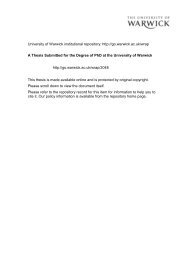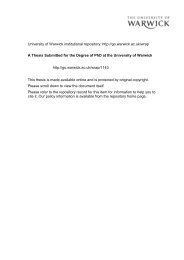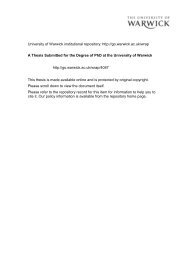From Page to Screen - WRAP: Warwick Research Archive Portal ...
From Page to Screen - WRAP: Warwick Research Archive Portal ...
From Page to Screen - WRAP: Warwick Research Archive Portal ...
You also want an ePaper? Increase the reach of your titles
YUMPU automatically turns print PDFs into web optimized ePapers that Google loves.
uniqueness, they all have in common the underlying discussion of different aspects<br />
(multiplicity, simultaneity, choice, and organised as well as random collage) ofwhat can<br />
be summarised as non-linearity, which raises the question of the value of a repeated<br />
exploration ofissues such as non-linearity in hypertext.<br />
While hypertext is arguably better suited <strong>to</strong> represent a non-linear arrangement of text<br />
elements, I have <strong>to</strong> disagree with hypertext theorists who conclude that the new medium<br />
therefore devalues previous print experiments for two reasons. Firstly, I believe that itis a<br />
fallacy <strong>to</strong> conclude that hypertext can au<strong>to</strong>matically generate meta-statements about the<br />
conventions of literature similar <strong>to</strong> those print texts can make. The second fallacy in<br />
discussion of pro<strong>to</strong>-hypertexts is <strong>to</strong> assume that they want <strong>to</strong> solve the problems that<br />
they discuss on a meta-textual level rather than using the inherent contradiction between<br />
the surface and the deep structure ofthe narrative.<br />
Language experiments function only in opposition <strong>to</strong> conventions; it is because they are<br />
firmly rooted in a print tradition that they can defamiliarise them. This therefore both<br />
forces and allows them <strong>to</strong> express theoretically what hypertext wants <strong>to</strong> realise. A text<br />
like Robert Coover's "Babysitter":", with half a dozen mutually exclusive versions of a<br />
Babysitter's evening that are presented in an arrangement that is inevitably linear but in<br />
effect parallel, is often quoted as one of the print pro<strong>to</strong>-hypertexts that is "straining at<br />
the typographical leash"'" and that might benefit from conversion in<strong>to</strong> a hypertext. But<br />
would it? For me it is a text that works well because it is in print, not even though.<br />
Readers can recognise their confusion and the contradictions in the text as a deliberate<br />
technique used by the author <strong>to</strong> make complex comments on narrative reality and<br />
temporal simultaneity and exclusiveness offictional events, rather than an accidental lack<br />
of coherence. The implied statements about the instability of logical and temporal<br />
relations in fiction and our assumptions about them, is supported (and not contradicted)<br />
126Robert Coover, "The Babysitter", in: Pricksongs andDescants (London: Picador, 1973) pp. 165 - 193-<br />
127 Jane Y. Douglas and Gordon Howell, "The Evolution of Interactive Fiction", Computer Assisted<br />
Language Learning: An Intemationalfoumal, vol. 2 (1990), 93-109 (P·96)·<br />
Chapter 2 - page 84





